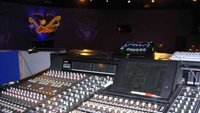Vetting RF systems for the presidential debate

As a long-time expert in RF frequency coordination, Larry Estrin has been director of audio and production communications for the Commission on Presidential Debates since the Clinton era. Working in a world that has become progressively more security-laden and RF-saturated with each election cycle has helped him work the kinks out of the process, but there was a fresh surprise during the town hall-style debate held at Belmont University Oct. 7.
Estrin chose the Audio-Technica 5000 Series as his primary RF system. With the candidates free to roam the stage under the town hall format, Barack Obama and John McCain each had a handheld Audio-Technica AEW-T5400 condenser microphone/transmitter, backed up with an AT898cW cardioid lavalier mic. Moderator Tom Brokaw, who was stationary, wore two of the latter. Waiting in the wings were identical spare handheld wireless AEW-6100s, while the last line of defense against a wireless disaster was a pair of wired AEW-6100 microphones.
With more than 56 million Americans watching the live broadcast, redundancy proved to be both prudent and necessary. At one point, a seated McCain laid his handheld microphone in his lap even as he continued speaking. “Without the lav backup, there would have been no audio,” Estrin said. The lavalier channel was opened immediately by audio mixer Michael Abbott, working on a Yamaha PM1D digital console above the stage area. So instead of a glitch there was irony, because the Republicans had initially insisted that there be no lavalieres, having been stung by a live one during the VP debate a week before in St. Louis, where Republican Sarah Palin got off the unscripted “Can I call you Joe?” line.
The audio crew stepped up its RF game this year, including using three NFL wireless coordinators on-site tracking every possible frequency, including those used by the Secret Service. Also in play was a complex wireless IFB system, with a Lectrosonics intercom system used on the stage floor and a Riedel system communicating within Belmont University’s Curb Event Center and integrated with an HME paging system in the CBS pool trucks.
Acknowledging that this would be the last round of presidential debates before the change to digital television puts white space in play, Estrin said, “Frequency coordination will continue to grow in importance. I expect that the manufacturers of wireless microphones and in-ear monitor systems will… develop digital audio transmission technologies from the ground up and stop trying to put Band-Aids on the existing old technology, which has been in use for several decades.”
For more information, visit http://www.bestaudio.com/Freq_coord.htm and www.audio-technica.com.
The professional video industry's #1 source for news, trends and product and tech information. Sign up below.
